OFC Spotlights Optical Connectivity
The Optical Fiber Communications Conference & Exhibition explored emerging optical connectivity technologies, including optical transmitters, multi-fiber cables, and connectors.
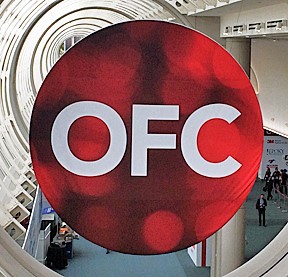 The Optical Fiber Communications Conference & Exhibition recently held in San Diego is the prime showcase of current and next-generation optical network communication technology. With over 700 exhibitors and 15,000 registered attendees, this conference filled both levels of the San Diego Convention Center. In addition to an extensive array of live demonstrations on the exhibit floor, OFC included more than 450 peer-reviewed papers, more than 180 invited and tutorial presentations, 10 workshops, six panels, and 55 short courses that explored every aspect of emerging optical connectivity technology. While the primary emphasis of OFC is on medium- to long-distance, high-speed optic links, active optical cables (AOCs) and direct-attach copper cable (DAC) assemblies used in short-reach rack-to-rack applications were actively promoted.
The Optical Fiber Communications Conference & Exhibition recently held in San Diego is the prime showcase of current and next-generation optical network communication technology. With over 700 exhibitors and 15,000 registered attendees, this conference filled both levels of the San Diego Convention Center. In addition to an extensive array of live demonstrations on the exhibit floor, OFC included more than 450 peer-reviewed papers, more than 180 invited and tutorial presentations, 10 workshops, six panels, and 55 short courses that explored every aspect of emerging optical connectivity technology. While the primary emphasis of OFC is on medium- to long-distance, high-speed optic links, active optical cables (AOCs) and direct-attach copper cable (DAC) assemblies used in short-reach rack-to-rack applications were actively promoted.
Many of the products being shown on the exhibition floor focused on state-of-the-art components such as optical transmitters, receivers, splitters, combiners, modulators, multi-fiber cables, as well as connectors. The entire universe of optical connectivity components, from semiconductor wafer processing, wire bonding, and materials, to system-level packaging was represented. Manufacturers of manual and automated optical cable test and evaluation systems, as well as fiber splicers were also present in force. Several suppliers, such as HUBER+SUHNER and MACOM, offered products that spanned the spectrum from RF frequencies to light. A huge contingent of suppliers, many of which are based in Asia, offered pluggable optical transceivers and cable assemblies, including SFP28, QSFP, QSFP28, QSFP-DD, QSFP SR8, QSFP DR4, and OSFP FR4. These ubiquitous interfaces are designed to deliver data rates from 25 to 400Gb/s with reach that varies from three meters to 40 kilometers.
A few general observations:
Devices based on silicon photonics took center stage as technological and assembly advances drive down costs while increasing density and performance.
PAM4 coding has become the standard in high-speed optical data transmission with the objective of achieving well-defined eye diagrams, which were evident at many live demonstrations.
Anticipation of upcoming 5G networks and related infrastructure upgrades spurred promotion of precision subminiature coax and pluggable optical I/O connectors.
Similar to what is going on in the copper electronic connector market, suppliers are partnering with manufacturers of related products to demonstrate a system solution. Many connector demonstrations credited multiple suppliers of components, such as ASICS, cable, and test equipment contributors.
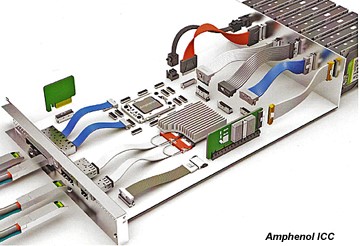 Consolidation continues to be a significant trend in this market segment. In order to gain access to a required technology, larger suppliers are forming strategic partnerships or simply buying a smaller company. Amphenol recently acquired Ardent Concepts to gain access to their compressive termination technology, which enabled the development of the LinkOVER technology, a key aspect of the Amphenol OverPass copper interconnect system. Both Amphenol and Ardent booths featured this new interface.
Consolidation continues to be a significant trend in this market segment. In order to gain access to a required technology, larger suppliers are forming strategic partnerships or simply buying a smaller company. Amphenol recently acquired Ardent Concepts to gain access to their compressive termination technology, which enabled the development of the LinkOVER technology, a key aspect of the Amphenol OverPass copper interconnect system. Both Amphenol and Ardent booths featured this new interface.
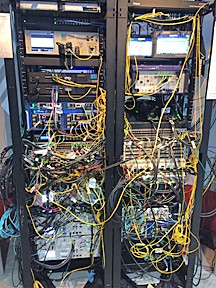 Ethernet in its many iterations appeared throughout the exhibit floor. The Ethernet Alliance hosted a large booth that featured a pair of racks that demonstrated 10, 25, 50, 100, and 400Gb Ethernet using equipment components and services from 21 participating suppliers, including TE Connectivity. The new 2019 Ethernet roadmap charts its evolution from 10 Mb/s in 1980 to current variations, including 2, 5, 25, 50, 200, and 400GbE, with a possible future link to 800GbE. Broad adoption of GbE is now evident in many market segments, including automation, automotive, enterprise, data center cloud, and mobile providers.
Ethernet in its many iterations appeared throughout the exhibit floor. The Ethernet Alliance hosted a large booth that featured a pair of racks that demonstrated 10, 25, 50, 100, and 400Gb Ethernet using equipment components and services from 21 participating suppliers, including TE Connectivity. The new 2019 Ethernet roadmap charts its evolution from 10 Mb/s in 1980 to current variations, including 2, 5, 25, 50, 200, and 400GbE, with a possible future link to 800GbE. Broad adoption of GbE is now evident in many market segments, including automation, automotive, enterprise, data center cloud, and mobile providers.
Several suppliers showed pluggable interfaces designed for feed-through optical backplane applications, but there was no evidence of interest in optics embedded in a backplane.
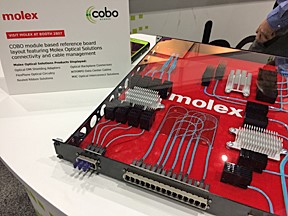 Amphenol ICC continues to market their Leap mid-board optical transceiver but there were few new entrants in this product segment. The charter of the Consortium for On-Board Optics (COBO) is to bring interoperable on-board optics to the Network Industry. They hosted a booth that featured a 400G optical channel. The updated 1.1 COBO specification was released in December 2018, with further revisions expected as signaling protocols are defined. Supporting members of this organization include leading connector manufacturers Amphenol, HUBER+SUHNER, Molex, Rosenberger, Samtec, Senko, Sumitomo, TE Connectivity, USCONEC, and Yamaichi.
Amphenol ICC continues to market their Leap mid-board optical transceiver but there were few new entrants in this product segment. The charter of the Consortium for On-Board Optics (COBO) is to bring interoperable on-board optics to the Network Industry. They hosted a booth that featured a 400G optical channel. The updated 1.1 COBO specification was released in December 2018, with further revisions expected as signaling protocols are defined. Supporting members of this organization include leading connector manufacturers Amphenol, HUBER+SUHNER, Molex, Rosenberger, Samtec, Senko, Sumitomo, TE Connectivity, USCONEC, and Yamaichi.
Although OFC does not attract as many traditional connector manufacturers as DesignCon, several industry leaders featured their latest copper and fiber interfaces.
The Amphenol booth showcased their high-speed backplane and pluggable connectors, including QSFP-double density (QSFP-DD) and OSFP small form factor connectors in support of next-generation 800G applications.
Molex featured a large display of high-speed copper and optical interconnects, which included a live demonstration of 400Gb Ethernet over three meters of copper cable terminated in QSFP-DD connectors transitioning to 100Gb over 11.1km of single mode fiber, for a total throughput of 12.8TBs. Molex partnered with allied suppliers, including Innovium (switch silicon), Teralynx (chips), Cisco (switches), and Ixia (test equipment) to demonstrate a system-level solution.
Molex Optical Solutions Group is expanding their commitment to developing coherent optical modules with a recently announced investment in Elenion Technologies LLC, a leader in silicon photonics-based chip design. They will be collaborating on developing optical connectivity products for telecom and datacom applications.
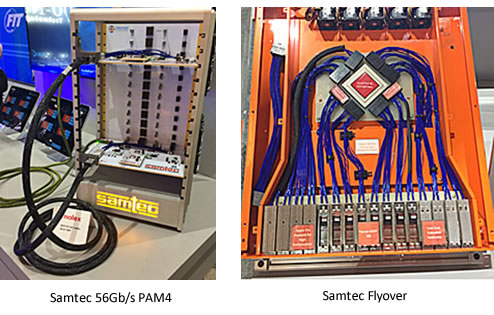
Samtec has long promoted a silicon-to-silicon concept and demonstrated high-end performance of both copper and fiber interfaces. One demonstration featured 56Gb/s PAM4 over three meters of cable to a Flyover QSFP-DD port.
Another demonstration operated at 112 Gb/s PAM4 using their NovaRay cable-to-board connectors.
Samtec also showed a copper Flyover concept that linked a processor or ASIC directly to a variety of pluggable I/O ports.
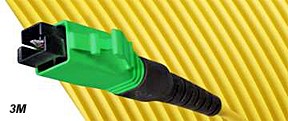 OFC offered a perfect opportunity to introduce several new separable optical connectivity systems. 3M Electronic Materials Solutions Division announced a new expanded beam optical connector that is scalable from 12 to 144 single or multimode fibers. This unique interface features reduced insertion loss and susceptibility to contamination at the optic interface, making it ideal for harsh environments as well as data center applications.
OFC offered a perfect opportunity to introduce several new separable optical connectivity systems. 3M Electronic Materials Solutions Division announced a new expanded beam optical connector that is scalable from 12 to 144 single or multimode fibers. This unique interface features reduced insertion loss and susceptibility to contamination at the optic interface, making it ideal for harsh environments as well as data center applications.
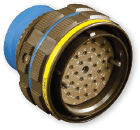
Glenair rugged circular connectors.
Foxconn Interconnect Technology (FIT) showcased a 400Gb PAM4 bi-directional (8X50) 100-meter multimode fiber link driven by QSFP-DD optical transceivers. They also offer an extensive line of 10, 25, 40, 100, and 400Gb Ethernet transceivers.
Glenair is generally recognized for their extensive line of rugged circular and rectangular connectors used in aviation and aerospace electronic applications. They also offer a series of photonic devices, including multi-gigabit connectors, video media converters, and transmitters for use in mission-critical applications.
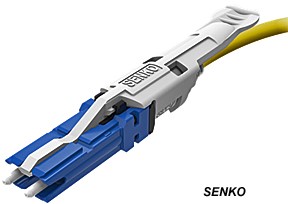 Senko Advanced Components showed their high-density CS duplex connector, which is 40% smaller than the standard LC Duplex. This push/pull connector has been optimized for 400G data center applications.
Senko Advanced Components showed their high-density CS duplex connector, which is 40% smaller than the standard LC Duplex. This push/pull connector has been optimized for 400G data center applications.
They also introduced their new SN optical connector. This duplex connector utilizes proven 1.25mm ferrule technology and offers significant improvements in density as well as design flexibility. Four of these connectors can be mated to an OSFP/QSFP-DD adapter to simplify break-out applications.
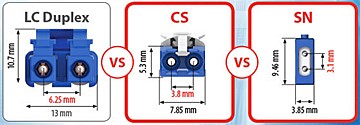
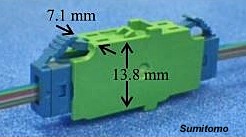 Sumitomo Electric promoted their FlexAirConnecT FO expanded beam connector that features exceptionally low mating forces and insertion loss. Applications include optical backplanes and on-board interconnect in servers and switches.
Sumitomo Electric promoted their FlexAirConnecT FO expanded beam connector that features exceptionally low mating forces and insertion loss. Applications include optical backplanes and on-board interconnect in servers and switches.
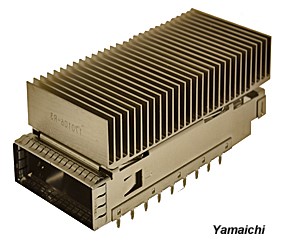 Yamaichi Electronics displayed their QSFP-DD pluggable transceivers module to support 112G PAM4 signaling, as well as their extensive line of CFP2, 4, and 8 pluggable modules for up to 400GbE applications.
Yamaichi Electronics displayed their QSFP-DD pluggable transceivers module to support 112G PAM4 signaling, as well as their extensive line of CFP2, 4, and 8 pluggable modules for up to 400GbE applications.
USCONEC featured an extensive array of fiber optic connectors, including their blind-mateable, expanded beam MXC interface that offers greater fiber density and a ruggedized strain relief.
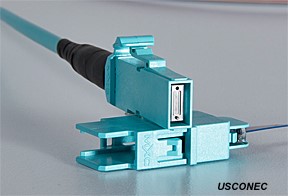
They are also in the process of developing the push-pull MDC duplex connector, which will enable 3X cabling density and target break-out applications.
Exhibitors and live demonstrations at both DesignCon 2019 and OFC pointed the way to how next-generation equipment will be capable of supporting the vastly increasing amount of data created by the IoT, Gen 5 wireless communications, Industry 4.0, and autonomous transportation.
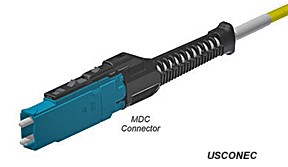
Like this article? Check out our other New Technology, high-speed, Ethernet, Industry News, and 2019 articles, and our Datacom/Telecom market page.
- Optics Outpace Copper at OFC 2024 - April 16, 2024
- Digital Lighting Enhances your Theatrical Experience - March 5, 2024
- DesignCon 2024 in Review - February 13, 2024





